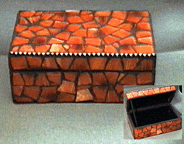Mosaic Artist
Insider Info
Mosaic art is an ancient art form enjoying a renewed popularity in the
U.S. and Canada. The mass-produced kind of mosaics are already a hot item
at gift and specialty shops, but serious artists and craftspersons are choosing
mosaics more and more to express their creativity.
"Interest is definitely up!" says Sonia King of the Society of American
Mosaic Artists (SAMA).
A mosaic artist pieces together a picture or design out of small bits of
material. That material is usually tiles (called tesserae) or broken china
and porcelain (called pique assiette). Then the artist seals it in a cement
or plaster base for display as a work of art or to use as a household item,
such as a table.
Someone with a background in art will create her own designs. Computer
software can be useful for laying out the pattern on to which the tiles are
placed.
Beginners and those who don't have the time or desire to do their own artwork
can purchase patterns, kits, and other tools and materials from tile and mosaic
supply stores online or locally.
Throughout history, mosaics have been an important art form. In ancient
Greece and Italy, they were generally made out of pebbles and used to decorate
buildings.
Today, a wide variety of materials are used, including glass, stone, beads,
china, tile, and gemstones. Modern developments in adhesives and synthetic
resins have allowed artists to be even more creative.
Mosaicists decorate a wide variety of items with mosaics. Tables, chairs,
clocks, mirrors, birdhouses, trivets, boxes, and vases represent some types
of movable items.
Others decorate buildings, subways, and public fountains. Some artists
specialize in themes, such as tributes to nature, or create remembrances of
their genealogy by using the family china for pique assiette.
Mosaic techniques include the following: direct, indirect (reverse), or
double reverse. These describe how the mosaic patterns are placed or transferred
onto the desired objects.
In the traditional direct method, the tiles are placed directly on to the
setting material. To learn more about the techniques, visit the Mosaic Matters
website.
Mosaic artist Faunus says, "The most difficult part is cutting consistent
sizes of desired shapes and the flow of the design. One is limited only by
one's imagination.
"Glass can be very dangerous to work with. I recommend cutting it rather
than simply shattering it. Minute pieces are often left scattered about, so
one must be very careful to limit his or her work to a specific area so as
to make cleanup easier and less of a hazard. Protective eyewear is a must!"
If you want to make a career out of being a mosaic artist, King warns that
"it's very difficult to make a good living at it here, although in England
there are quite a lot of full-time mosaicists. It's not a career path yet."
If you're really serious, some art training and a couple years of experience
will get you on your way, she says.
Matt Hickerson and Jennifer Kent, however, have made quite a success of
their mosaic business, which focuses primarily on mirrors. Their website was
so successful in attracting customers that they had to phase it out, except
as an archive.
"We started selling and advertising and marketing online because we wanted
to get our work exposed outside of [our area]," they explain.
Since developing the site, "we have literally been selling them all over
the world -- North America, South America, Europe, Australia, Asia and the
Middle East. The website is directly responsible for that. It's working out
quite nicely."
Some people have also set up businesses that sell mosaic supplies. If you're
accomplished at mosaic art, you can do workshops.
Artist Bas Degroot says, "I used to teach a lot, at first to provide for
some stability in a fickle profession, but more and more because I just wanted
to share and help people find an enriching hobby, sometimes the start to a
new profession. Eventually, I felt I needed more time for myself."
Getting Started
 |
| A mosaic box that is anything but square. |
| Courtesy of: Faunus |
You don't need a lot of expensive tools and materials in the beginning.
If you start with a workshop, these are usually supplied. Basic equipment
includes a tile or glass cutter, scissors, craft knives, safety goggles, mixing
bowls for the mortar and grout, and the tiles or broken china you will place
on your base.
If you want to pursue mosaics as a hobby, it isn't difficult to learn.
"Anyone can get some tiles or smash some china and grout it -- that part can
be learned quickly," says King. "But if you want to be a serious artist, a
background in fine art really helps."
Faunus learned the craft through an apprenticeship with a local artist.
"He taught me the basics of cutting the glass and applying it to a base, usually
made of wood, glass or concrete," explains Faunus.
"It takes a lot of practice to become good at it. I started with simple
designs, and then through observation of my mentor and the natural flow of
nature learned how to place pieces together to form more elaborate designs."
According to King, "There is a dearth of information on mosaic art." That's
something the SAMA hopes to change.
In the meantime, you can try to find workshops through a local arts organization
or one of the websites. King also recommends teaching yourself through one
of the books available.
Associations
Society of American Mosaic Artists (SAMA)
P.O. Box 624
Ligonier
,
PA
15658-0624
USA
Internet
:
http://www.americanmosaics.org/
Links
Mosaic Matters
As well as technical help, it offers links to workshops, exhibitions,
and suppliers
Mosaic Network
Links to mosaic artists, associations, suppliers, and workshops
in other countries
History of Mosaic Art
Hickerson and Kent's business site
Mike Mosaic's Studio
Great site showcasing samples of work and links to courses
Back to Career Cluster